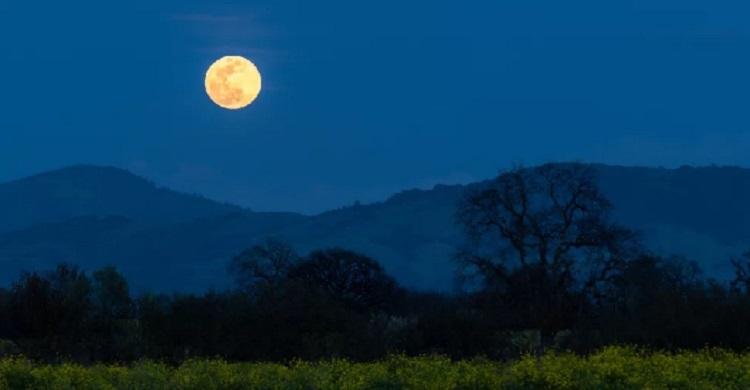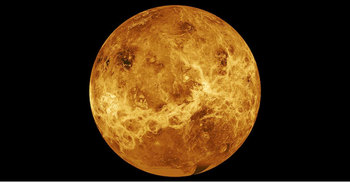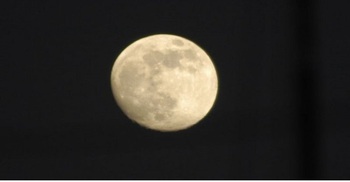Catch March's full supermoon on Sunday

March's full moon — by some accounts a supermoon — will dazzle skywatchers this Sunday (March 28), as spring's warm weather invites more people to venture outside to gaze upward.
The full moon lasts just an instant, but dedicated moon watchers can catch it at 18:48 UTC (at 12:42am in Bangladesh time) on Sunday, when the moon appears opposite the sun in Earth-based longitude, according to a NASA statement. People who miss this fleeting moment will still be able to see a big, round moon — the rocky satellite will appear full for three days, from Saturday morning (March 27) through early Tuesday morning (March 30).
And, while it might be hard to tell, March's moon is by some accounts a supermoon, depending on how you interpret the term "supermoon." This word was coined in 1979 by astrologer Richard Nolle, who said it refers to either a new or full moon that falls within 90% of perigee, when the moon is closest to Earth. Different publications and experts, such as TimeandDate.com and astronomer Fred Espenak, have different thresholds for determining when the moon is close enough to qualify as a supermoon. This year, some are saying that 2021 will have four full supermoons (from March to June), while others are saying there will be three supermoons (from April to June), and some argue there will only be two full supermoons (in April and May), NASA reported.
So, which moon will be the "superest"? "The full moons in April and May are nearly tied as the closest full moons of the year," NASA said in the statement. "The full moon on May 26, 2021, will be slightly closer to the Earth than the full moon on April 26, 2021, but only by a slim 0.04%."
This weekend's full moon has many names, but it is often called the Worm Moon, according to the reporting by the Maine Farmer's Almanac in the 1930s on what the Native Americans called the full moon. According to this lore, Indigenous tribes in the American South reportedly named it "Worm Moon" after earthworms that pop out around this time of year. These invertebrates were wiped out in the region by glaciers at the end of the last ice age about 12,000 years ago, but they were reintroduced with the arrival of Old World settlers who brought invasive species from Europe and Asia, according to NASA. Once the snowpack melts in the spring, these invasive earthworms often wriggle about.
Other names for March's moon include the Crow, Crust, Sap and Sugar Moon. According to the Maine Farmer's Almanac, the northwestern tribes in the United States called it the Crow Moon, due to the cawing of crows that signaled the end of winter, while other groups called it the Crust Moon, after the crust of snow that freezes at night, or the Sap or Sugar Moon, because early spring is the time of year for tapping maple trees.
Meanwhile, in the Hebrew calendar, this full moon falls in the Middle of the month of Nisan, which is tied to the observance of Passover (or Pesach), a holiday that commemorates the biblical event of the Jewish people leaving behind slavery in Egypt. This year, Passover begins at sundown on March 27, and it lasts until nightfall on April 4.
According to the western Christian ecclesiastical calendar, this moon is known as the Paschal Moon, which is key to determining the date of Easter. The word "Paschal" is the Latinized word for Pesach. Usually, Easter is celebrated on the first Sunday after the first full moon of spring. However, due to differences in the Eastern and Western church calendars, this year Easter will fall on two dates: April 4 for Western Christianity, which views March's moon as the first full moon of spring, and May 2 for the Eastern Orthodox Church, which views the next full moon as the Paschal Moon, NASA reported.
For Hindus, this full moon corresponds with the festival of colors, known as Holi, which celebrates the triumph of good over evil, as well as the beginning of spring. This year, Holi falls on March 29. In Sri Lanka, this full moon is called Medin or Madin Poya, and it marks the Buddha's first meeting with his father after his enlightenment, NASA reported. For followers of Islam, this full moon falls in the middle of the month Sha'ban, the month before Ramadan.
Skywatchers will also be able to see other celestial happenings, unless cloudy skies preclude them. On Sunday, the day of the full moon, Mars will be the only visible planet after night falls. Watch for it on the western horizon, NASA recommended.
Source: Live Science







